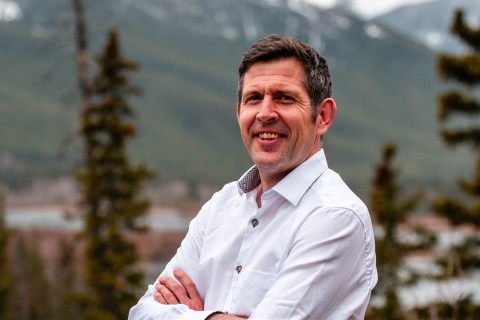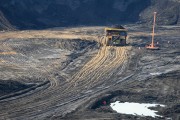It's official: the unabashed oil sands PR blitz is in full swing. It's image, not impacts that industry is addressing, and that's a problem.
CAPP, along with nine other industry associations has launched "Alberta is Energy," a campaign complete with town hall meetings, a website and a media plan to sell oil and gas. Two recently uploaded YouTube videos highlight key messaging about the oilsands industry - that it's a clean, green, money-making machine.
But wait: don't drink the Kool-Aid yet because the video's "balanced perspective" is not-so-balanced. Some of the most important issues to stakeholders are downplayed, misrepresented or ignored altogether. Let's set the record straight.
On oilsands reclamation
The claim that, "in the future, all oilsands development will be reclaimed" is more than a little optimistic given industry's track record. Of the 600 square kilometres of land disturbed by oilsands mining operations, only 1.04 square kilometres is government certified as reclaimed. Calculations of financial securities to cover the cost of reclamation are not publicly available, inadequate and place Albertans and Canadians at risk of bearing the liability of costly clean up in the future.
On tailings "ponds" and wildlife
We hear about the shortened time it now takes to reclaim a tailings "pond" in the video. Unfortunately, this is not representative of industry's failure to address tailings clean up. In fact, we found only two companies have submitted plans in accordance with Directive 074: Tailings Performance Criteria and Requirements for Oilsands Mining Schemes, suggesting those two companies may begin to manage tailings.
Tailings lakes cover more than 130 square kilometres - an area larger than Vancouver and set to grow further with liquid tailings rapidly expanding by 200 million litres every day. And they aren't wildlife-friendly, killing over 1,6 00 ducks in one incident in 2008. Recent data unearthed through a Freedom of Information and Protection of Privacy request (so much for transparency) shows oilsands development killing 27 black bears, 67 deer, 31 red foxes, 21 coyotes and other animals between 2000 and 2008 (and that's only industry reported deaths from Syncrude, Suncor and Shell Canada's Albian Sands).
00 ducks in one incident in 2008. Recent data unearthed through a Freedom of Information and Protection of Privacy request (so much for transparency) shows oilsands development killing 27 black bears, 67 deer, 31 red foxes, 21 coyotes and other animals between 2000 and 2008 (and that's only industry reported deaths from Syncrude, Suncor and Shell Canada's Albian Sands).
As for leakage, we still don't know how much tailings lakes are leaking, as neither government nor industry will publish the data. One analysis puts it at 11 million litres a day.
On regulations
We're not sure we'd call the oilsands industry "on e of the most highly regulated." As of June 2009, about 60% of the total oilsands area has been leased to companies for extraction. That's 84,000 square kilometres of land leased by the Alberta government prior to land-use planning and without environmental assessment. And media reports on the government's own scorecard for management of the oilsands last week showed only two (short-term) out of the 21 goals of Alberta's much delayed plan, Responsible Actions, are complete.
e of the most highly regulated." As of June 2009, about 60% of the total oilsands area has been leased to companies for extraction. That's 84,000 square kilometres of land leased by the Alberta government prior to land-use planning and without environmental assessment. And media reports on the government's own scorecard for management of the oilsands last week showed only two (short-term) out of the 21 goals of Alberta's much delayed plan, Responsible Actions, are complete.
On water use
Ungluing the bitumen from the sands is a water-consuming process, using two barrels of water to produce one barrel of bitumen from mining and one barrel of water per barrel of bitumen from in situ production. While water recycling is commendable and increases efficiencies, it doesn't return water to the natural cycle and large withdrawals are still made. According to the awarded water licenses, current and proposed projects could withdraw more than 15% of the Athabasca River's water flow during its lowest flow periods and industry continues to resist halting withdrawals during low flow periods.
natural cycle and large withdrawals are still made. According to the awarded water licenses, current and proposed projects could withdraw more than 15% of the Athabasca River's water flow during its lowest flow periods and industry continues to resist halting withdrawals during low flow periods.
On greenhouse gas emissions
Greenhouse gas emissions from oilsands production are not decreasing in real terms and certainly not by 30% as claimed. Rat her, the oilsands are Canada's fastest growing source of emissions. That's because oilsands extraction and upgrading are estimated to be three to 4.5 times as intensive per barrel as conventional crude production from North America. And the video neglects to mention that Canada still doesn't have regulations to reduce greenhouse gases.
her, the oilsands are Canada's fastest growing source of emissions. That's because oilsands extraction and upgrading are estimated to be three to 4.5 times as intensive per barrel as conventional crude production from North America. And the video neglects to mention that Canada still doesn't have regulations to reduce greenhouse gases.
On stakeholder relations
It would be hard to imagine the oilsands industry is "cultivating effective, productive relationships with all stakeholders" as asserted in the video. Numerous First Nations have launched legal challenges to fight the way oilsands development is proceeding within their territories. One such battle is heating up in the Supreme Court with Chief Don Testawich of the Duncan's First Nation near Peace River saying, "our traditional territory is being overrun and cut to pieces by oilsands, major pipelines, gas fields and major power projects."
The oilsands industry has undeniable and ever-growing impacts that need to be addressed. Mounting continued PR campaigns that talk at Albertans and Canadians won't change those impacts. We'd like to suggest an alternate first step: admit there are problems. Next step: fix them.









